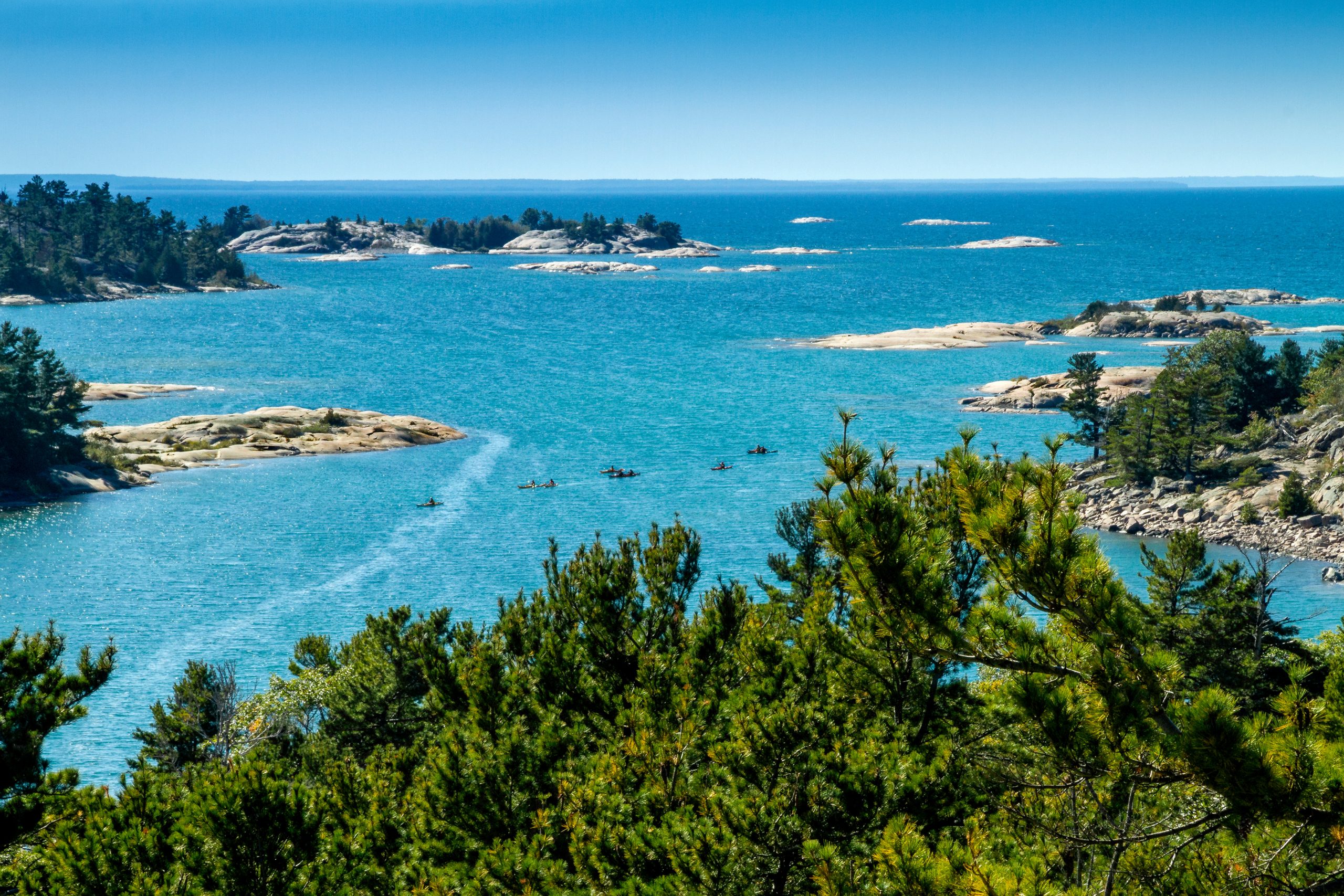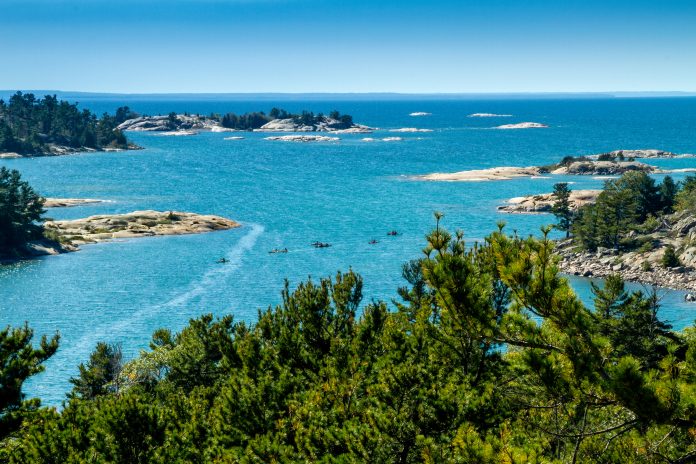Formed after the last ice age and taking their current shape about 3,000 years ago, the Great Lakes — Huron, Ontario, Michigan, Erie, and Superior — together account for 84 percent of the surface freshwater supply in North America.
These five lakes provide the fresh water for around 40 million people in the United States and Canada, while also creating economic opportunity, offering options for recreational activities, and serving as habitats for various species.
We know you appreciate the Great Lakes for all of the reasons above, but here are 60-something more reasons to love them.
- There are currently 20 Native American tribes in the Great Lakes region.
- More than 30 million people live in the Great Lakes basin, which covers parts of the United States and Canada. This accounts for about 10 percent of the U.S. population and more than 30 percent of the population of Canada.
- Forty million people in the U.S. and Canada rely on the Great Lakes for drinking water.
- The Great Lakes hold 84 percent of the surface fresh water in North America.
- On a larger scale, 21 percent of the world’s supply of surface fresh water is in the Great Lakes.
- If the water from the Great Lakes were spread out over the surface of North America, it would cover the entire continent in about 3.5 feet of water.
- Ninety percent of the fresh water in the U.S. is in the Great Lakes.
- All of the Great Lakes are connected by various lakes and rivers.
- The Great Lakes make up the largest freshwater system in the world.
- The Great Lakes touch eight U.S. states: Michigan, Illinois, Wisconsin, Minnesota, Ohio, Indiana, Pennsylvania, and New York.
- The total combined shore length of the Great Lakes is about 11,000 miles.
- Shoreline lengths by lake:
- Superior: 2,726 miles Michigan: 1,659
- Huron: 3,827 (the longest shore length, including the Lake Huron islands)
- Erie: 871
- Ontario: 726

Boaters explore an inlet at Pictured Rocks National Lakeshore on Lake Superior. // Photograph from Adobe Stock
- The name “Lake Superior” comes from the French lac supérieur, meaning “upper lake.”
- Lake Superior is the largest freshwater lake in the world by surface area at about 31,700 square miles.
- The deepest point of Lake Superior is 1,330 feet, which is taller than the Empire State Building.
- Lake Superior has more water than the other four Great Lakes combined.
- Even though Lake Superior contains over 50 percent of the water in the Great Lakes, it only has about 2 percent of the total number of fish.
- Lake Michigan’s shoreline constitutes 62 percent of the total shoreline in the Great Lakes basin.
- The formation of the Great Lakes goes back as far as the last ice age 3,000 years ago. A sheet of ice covered much of Canada and the northern U.S., the weight of which created basins. When the ice melted, these basins filled with water to become the Great Lakes.
- The fishing industry in the Great Lakes brings in about $7 billion every year and provides over 75,000 jobs annually.
- There are 139 fish species native to the Great Lakes.
- Lake sturgeon are the biggest fish species in the Great Lakes. The largest lake sturgeon ever caught in the Great Lakes was found in Lake Michigan. It was over 8 feet long and weighed around 300 pounds.
- Over 30 species of amphibians live in the Great Lakes region. There are 13 species of toads and frogs in the Michigan section of the region
- Common mammals of the Great Lakes region include the moose, beaver, gray wolf, Canada lynx, little brown bat, river otter, and coyote.
- There are about 180 species in the Great Lakes that are not native to the region. Only 34 percent of them are classified as invasive. A new invasive species is discovered on average every 28 weeks.
- The National Oceanic and Atmospheric Administration has supported 92 restoration projects aimed at preserving and restoring habitats around the Great Lakes. These projects have helped with restoration of over 4,700 acres of wildlife habitats.
- Major water withdrawals from the Great Lakes can cause ecological damage,Ã˝so Michigan‚Äôs Water Use Program moderates the amount of water taken from the Great Lakes and monitors the water levels each year. This is part of a larger-scale agreement called the Great Lakes-St. Lawrence River Basin Water Resources Compact, which requiresÃ˝the associated U.S. states and Canadian provinces to register water withdrawals and keep specific water reports.
- More than 22 million pounds of plastic pollution is addedÃ˝to the Great Lakes each year.
- Retention/replacement time associated with a lake is the amount of time it takes for a lake to move out pollutants. It corresponds to features of the lake such as currents, depth, volume, and size.
- Retention times for the Great Lakes: Superior: 191 years Michigan: 99 years Huron: 22 years Ontario: 6 years Erie: 2.6 years.
- In the time measured — since 1973 — there has never been a point when all of the Great Lakes have been completely frozen over at the same time.
- It is common for parts of the lakes to freeze over at some point during the winter but less frequent for entire lakes to freeze.
- Half of all the water in the Great Lakes is in Lake Superior.
- Lake-effect snow forms when cold air moves across warmer waters. Therefore, when cold air blows across the open waters of theÃ˝Great Lakes, it creates lake-effect snow.
- As global temperatures continue to rise, the ice cover on the Great Lakes is expected to decrease.
- Because of climate change, it is suspected that in about 30 years, Lake Superior will stay mostly ice-free during a standard winter season.
- In 1988, Vicki Keith became the first person to swim across all five of the Great Lakes.
- The Great Lakes historically had pirates, such as John Rackham, James Jesse Strang, and Dan Seavey. The most common goods valued by historical pirates of the Great Lakes included lumber, illegal alcohol, and various wild-game meats.

Kayakers paddle in Lake Huron’s Georgian Bay. // Photograph from Adobe Stock - Lake Huron has more individual islands than any other Great Lake, with over 30,000.
- French explorers originally called Lake Huron la mer douce, meaning “the freshwater sea.” The name it was officially given later came from the Huron people who inhabited the lake’s shore and surrounding areas.
- Lake Huron was the first of the Great Lakes to be reached by French explorers.
- The outlet of Lake Huron flows into Lake Erie through a series of rivers and lakes — from the St. Clair River to Lake St. Clair to the Detroit River and then into Lake Erie.
- About 2 billion gallons of water flow into Lake Huron from Lake Superior per hour.
- The Goderich mine is the largest salt mine in the world and lies deep under Lake Huron.

At 1659 miles, Lake Michigan’s shoreline is the only one among the Great Lakes that is 100 percent American. // Photograph from Adobe Stock. - The name “Michigan” comes from the Ojibwa word mishigami, meaning “great lake” or “large lake.” This means that Lake Michigan is essentially named “Lake Great Lake.”
- Lake Michigan is the second largest of the Great Lakes by volume.
- However, it is the third largest by surface area, smaller than lakes Superior and Huron.
- Michigan’s state stone, the Petoskey stone, is made of fossilized coral that is unique to Lake Michigan’s northern shores.
- The Charlevoix stone, which is considered a cousin of the Petoskey stone, features a similar but smaller honeycomb pattern created from the exoskeletons of the fossilized coral.
- Lake Michigan is the only Great Lake located entirely in U.S. territory.
- The biggest wave ever recorded in one of the Great Lakes was a wave in Lake Superior reaching nearly 29 feet high.
- Lake Huron is home to massive sinkholes on the lake floor.
- Manitoulin Island, in Lake Huron, is the largest of the Great Lakes’ islands and the largest island inside an inland body of water in the world.
- Beaver Island is the largest island in Lake Michigan. It is about 13 miles long and 6 miles wide and has a year-round population of about 600, many of Irish descent. You can get there by ferry or by plane and can rent a car or bike on the island. It is also known as one of the best places for dark- skies stargazing.
- The name “Ontario” originated from the Iroquoian word oniatarí:io, which translates to “lake of shining waters.”
- Lake Ontario is the only Great Lake with a direct link to an ocean — via the St. Lawrence River.
- On Saturn’s moon Titan, there is a lake a similar size and shape to Lake Ontario that was thus named Ontario Lacus.
- The Thousand Islands in the outlet of Lake Ontario don’t number exactly a thousand; they’re actually a group of over 1,500 isles.
- Mackinac Island‚Äôs M-185, an 8.2-mile road, is the only highway in the U.S. where motor vehicles are banned. The ban has been in effect since July 6, 1898. The island was the setting for the 1980 time travel romance Somewhere in Time, starring Christopher Reeve (fresh off his Superman success), Jane Seymour, and Christopher Plummer. In the movie, Reeve‚Äôs character travels back to 1912, so Mackinac‚Äôs no-carÃ˝policy and Victorian-era Grand Hotel made it the perfect setting.

Lake Huron’s Turnip Rock, near Port Austin is a hotspot for shoreline kayakers. // Photograph from Adobe Stock - Eighty percent of the water inflow to Lake Erie comes through the Detroit River.
- Lake Erie is the smallest of the Great Lakes by volume and the shallowest. It is also the warmest.
- Lake Erie has only about 2 percent of the total water in the Great Lakes but about 50 percent of
the fish. - Most of the land surrounding Lake
Erie is either designated for agriculture or consists of urban areas. - Lake St. Clair, in the Lake Erie basin, is home to the largest freshwater delta in the world.
- Lake Ontario is the only Great Lake that does not border Michigan; it’s also the only one to border just one state: New York.
Go Back in Time on Mackinac Island
The Grand Hotel on Mackinac Island plays a prominent role in the 1980 film . Since this time-bending romance was filmed on location, the Grand Hotel has held an annual Somewhere in Time Weekend since 1991.
This year, the event will take place the weekend of October 27-29, with activities on both Friday and Saturday. As part of the weekend package, guests will spend two nights at the Grand Hotel.
Activities include a special showing of Somewhere in Time, a tour of the movie‚Äôs filming locations, appearances from cast andÃ˝crew members, and receptions held both evenings. To learn more about the experience and included amenities, visit for more information.
Is There a SixthÃ˝Great Lake?
Students in the Midwest grow up learning about the five Great Lakes, often using the mnemonic “HOMES”: Huron, Ontario, Michigan, Erie, Superior. But for a brief 18 days in 1998, via a technicality, there was actually a sixth Great Lake: Lake Champlain.
Lake Champlain is located within the St. Lawrence River watershed along with the rest of the Great Lakes, but it doesn’t directly connect to the other five. It’s also significantly smaller in surface area — as in almost 17 times smaller — than Lake Ontario, the smallest Great Lake
by surface area.
When then-President Bill Clinton officially designated Lake Champlain as one of the Great Lakes, it allowed research money to be allocated to Lake Champlain under the National Sea Grant College Program.
The attention from the media and subsequent outcry from officials in the Midwest led to a swift demotion from “Great Lake” status, but the research funds still remained available.
This story is from the July 2023Ã˝issue of œ„∏€¡˘∫œ≤ Õºø‚◊ ¡œ magazine. Read more in our digital edition.
|
| Ã˝ |
|









